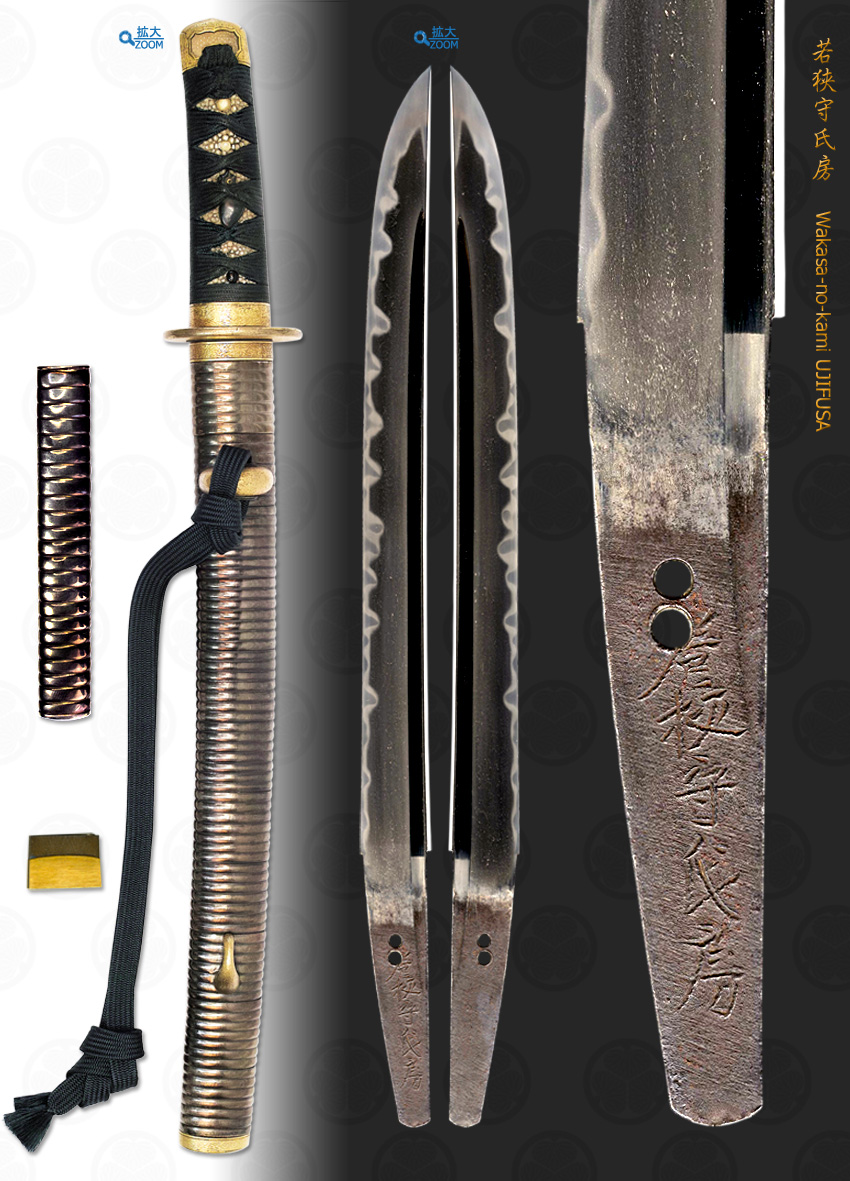with) Silver Notches scabbard Chisa-katana style Tanto Koshirae
Length of cutting edge 30.2cm Curvature 0.2cm Width of base 27.3mm Thickness of base 5.0mm
Forging(Hada): Forging is well-woven Itame-hada mixing with partial entwined flowing Masame ware that mostly appears along quenching area. Steel shows slightly darkish-blue impression with fine Nie sparkling glitter that generates moist skin of mottled Utsuri reflection on Hira-ji surface.
Temper(Hamon): Hamon is very fine Nie hard metal granules base, wavy Notare with undulating Gunome then tall Choji-ha and Togari-ha that are slanting downward or an isolated Tobiyaki outline. The entire Hamon shape on both sides are well matched. The interior of temper is full of misty Nioi and Sunagashi short lines of Nie streams.
Temper of tip(Boshi): Boshi is irregularly Midarekomi then creates a small circle then deeply turns back that generates side view of Jizou stone stature.
Tang(Nakago): Nakago is in UBU original. Two peg holes. Upper is Katte-sagari (slanting left) and lower forms Ō-Sujikai (greatly slanting left) filemarks. Back ridge of Nakago is flat and Kurijiri round heel shape. The signature in front is five large character that reads Wakasa-no-kami UJIFUSA 若狭守氏房.
The first smith UJIFUSA, real name [Kawamura Kyouzaburo, the initial smith name KANEFUSA], was born in the 3rd year of Tenbun (1534) as the 3rd son of Seizaemon KANEFUSA in Gifu, Mino province. He officially was given the way of legitimate son of KANEFUSA from his elder brother Iwami-no-kami KUNIFUSA in the 2nd year of Kouji (1556) to change his given name from Kyouzabuto to Seizaemon then moved to Seki town, Mino province.
In the 19th day, the 4th month, 13th year of Eiroku (1570) he enjoyed the official title of [Kiyozaemon-no-shuoi] and changed his smith name to UJIFUSA, then 3 days later he got an official district [Wakasa-no-kami] title granted by the Imperial Court.
He won the praise from the daimyo Oda Nobunaga 織田信長 to exclusively belong to him. In the 5th year of Tensho (1577) he moved to Azuchi castle town in Oumi province along with Oda Nobunaga to work exclusively as a vassal.
After the Incident at Honnō-ji (本能寺の変, Honnō-ji no Hen) referred to the forced suicide in the 21th day, the sixth month, the 10th year of Tensho (1582) of Oda Nobunaga, UJIFUSA returned to his home town Gifu with Oda Nobutaka's help then again came back to Kiyosu castle town under support of Sakuma Masakatsu. Passed away in the 11th day, the 5th month of Tensho 18th (1590) at 57 years old.
This is the work on after Eiroku 13th (37 years in his age) in the peak of Warning States period while Oda Nobunaga decided crucial battle of ANEGAWA, Ishiyama Hongan-ji War and Siege of Mount Hiei.
The top three character of Wakasa-no-kami 若狭守 is a bit on smaller side and the rest for smith name UJI FUSA 氏房 is relatively larger, that is one of his peculiar manner in his prime days on after 37 years old till matured 40's. Such large Sun-nobi style Tanto was common in his lifework to order of daimyo Oda Nobunaga himself or his vassal general Samurai in Owari domain then have been treasured in generations.
Nakago holds a good taste of patina to remain clear filemark and chisel of signature. Ujifusa has been praised as Waza-mono (the best cutting performance).
A sublime work of Silver Notches scabbard Chisa-katana style Tanto Koshirae consists of :
(click HERE for entire Koshirae / HERE for higher resolution images of each fitting)
•All metal fittings of Fuchi/kashira, Tsuba, Kuchi-kane, Ura-kawara, Kaeri-tsuno and Kojiri : Brass ground Wrinkles surface, unsigned
•Menuki : Assorted Shells design, Shakudo copper alloy ground, Gold Iroe
•Kozuka : Silver Notches design, polish surface, unsigned
•Tsuka (hilt) : White layskin, Nan'do (gray-indigo-blue) silk cord Tsumami-maki style lozenge wrap
Gold foiled Owari-style double layer Habaki collar, preserved in Shira-Saya plain wood mounting
Good old polish/Condition scale: excellent - very good (using a scale of mint-excellent-very good-good-fair-poor).
reference sword: Katana signed Wakasa-no-kami UJIFUSA-saku The 8th month, 2nd year of Genki (1571)
reference data :
Owari Tōkōfu Iwata Atou 1985 Publisher : Nagoya city Board of Education
Suzuki Takuo/Sugiura Yoshiyuki, Muromachi-ki Mino Toko-no kenkyu, Ribun-shuppan, 2006



